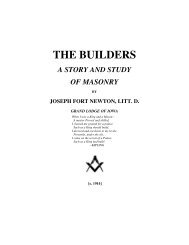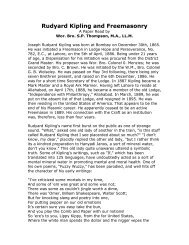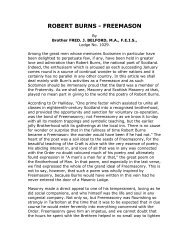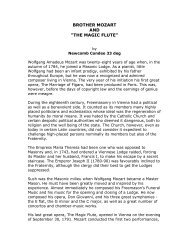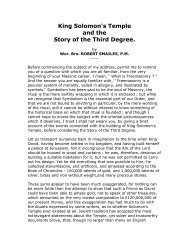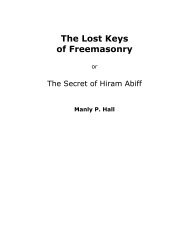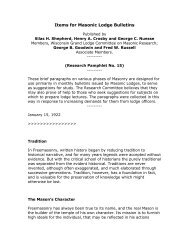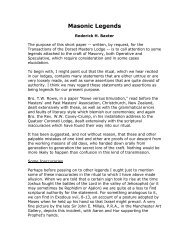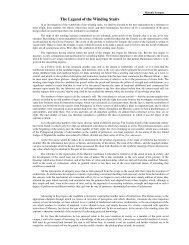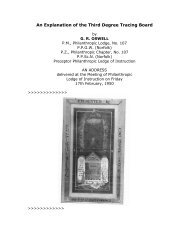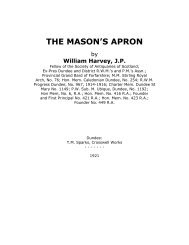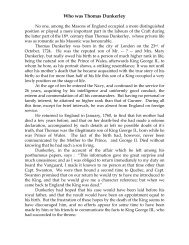Through the Key Hole - RoseCroix.org.au
Through the Key Hole - RoseCroix.org.au
Through the Key Hole - RoseCroix.org.au
Create successful ePaper yourself
Turn your PDF publications into a flip-book with our unique Google optimized e-Paper software.
21<br />
155<br />
To overcome this, a process known as Foundry Weld or Burning On<br />
would have been used. This method is as follows:<br />
The mould would have been built up to a certain height to accommodate<br />
<strong>the</strong> first pour. After <strong>the</strong> first pour, <strong>the</strong> crucibles would be recharged<br />
and <strong>the</strong> mould built-up for <strong>the</strong> second pour, with one difference,<br />
Bleed holes, bleeding into <strong>the</strong> hollow centre of <strong>the</strong> pillar would<br />
have to be placed a short distance up from <strong>the</strong> top of <strong>the</strong> first or last<br />
pour. His would bleed into <strong>the</strong> centre so as not to spoil any pattern<br />
work on <strong>the</strong> outside of <strong>the</strong> pillar. Any bronze that bled through <strong>the</strong><br />
bleed holes could be collected and re-used in <strong>the</strong> next smelt.<br />
and now <strong>the</strong> lodge watches as this elderly bro<strong>the</strong>r drops his cane<br />
on <strong>the</strong> floor and with great difficulty he lowers himself and sits<br />
down on <strong>the</strong> carpet next to John and welcomes him so he won’t<br />
be alone.<br />
When <strong>the</strong> Secretary gains control, he says “ What I am about to<br />
say you will never remember. What you have just seen, you will<br />
never f<strong>org</strong>et! Be careful how you live. You may be <strong>the</strong> only Mason<br />
some people will ever meet.”<br />
When all of <strong>the</strong> bronze for <strong>the</strong> second pour was ready, <strong>the</strong> pour<br />
would commence. Once <strong>the</strong> hot liquid bronze reached <strong>the</strong> bleed<br />
holes, <strong>the</strong> bronze would bleed off and more liquid bronze would be<br />
poured into <strong>the</strong> mould maintaining <strong>the</strong> heat of <strong>the</strong> pour.<br />
His hot bronze, after a period of time, would start to melt <strong>the</strong> top section<br />
of <strong>the</strong> last pour and <strong>the</strong> metals would start run and weld <strong>the</strong>mselves<br />
toge<strong>the</strong>r. This would be ascertained by <strong>the</strong> use of a copper<br />
sounding bar. The bleed holes would <strong>the</strong>n be plugged off and <strong>the</strong><br />
pour continued until all of <strong>the</strong> crucibles were empty. Thus <strong>the</strong> pours<br />
would continue until <strong>the</strong> pillar was cast to its full height.<br />
How <strong>the</strong> pillars were moved <strong>the</strong> 35 miles to Jerusalem and erected<br />
in <strong>the</strong>ir proper place, is a subject for separate research.<br />
N.B. Considerable research has been undertaken on this subject<br />
and assiduous students and researchers are directed to <strong>the</strong>ir nearest<br />
Masonic library where more publications and writings can be<br />
found.. For anyone in NSW, your attention is drawn to Vol. LV No.<br />
1, being <strong>the</strong> January 1960 issue of <strong>the</strong> NSW Freemason where an<br />
extensive article can be found on this subject—pages 27 to 33.



